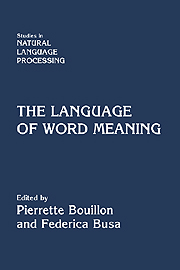Book contents
- Frontmatter
- Contents
- List of Contributors
- Preface
- Introduction: Word Meaning and Creativity
- Part I Linguistic Creativity and the Lexicon
- Part II The Syntax of Word Meaning
- 6 Introduction
- 7 Type Construction and the Logic of Concepts
- 8 Underspecification, Context Selection, and Generativity
- 9 Qualia and the Structuring of Verb Meaning
- 10 Sense Variation and Lexical Semantics: Generative Operations
- 11 Individuation by Partitive Constructions in Spanish
- 12 Event Coreference in Causal Discourses
- Part III Interfacing the Lexicon
- Part IV Building Resources
- Index
10 - Sense Variation and Lexical Semantics: Generative Operations
Published online by Cambridge University Press: 07 October 2011
- Frontmatter
- Contents
- List of Contributors
- Preface
- Introduction: Word Meaning and Creativity
- Part I Linguistic Creativity and the Lexicon
- Part II The Syntax of Word Meaning
- 6 Introduction
- 7 Type Construction and the Logic of Concepts
- 8 Underspecification, Context Selection, and Generativity
- 9 Qualia and the Structuring of Verb Meaning
- 10 Sense Variation and Lexical Semantics: Generative Operations
- 11 Individuation by Partitive Constructions in Spanish
- 12 Event Coreference in Causal Discourses
- Part III Interfacing the Lexicon
- Part IV Building Resources
- Index
Summary
Abstract
In this paper, we first outline some elements related to sense variation and to sense delimitation within the perspective of the Generative Lexicon. We then develop the case of adjectival modification and a few forms of sense variations, metaphors, and metonymies for verbs and show that, in some cases, the Qualia structure can be combined with or replaced by a small number of rules, which seem to capture more adequately the relationships between the predicate and one of its arguments. We focus on the Telic role of the Qualia structure, which seems to be the most productive role to model sense variations.
Introduction
Investigations within the generative perspective aim at modeling, by means of a small number of rules, principles and constraints, linguistic phenomena (either morphological, syntactic or semantic) at a high level of abstraction, level that seems to be appropriate for research on multilinguism and language learning. These works, among other things, attempt at modeling a certain form of “creativity” in language: from a limited number of linguistic resources, a potentially infinite set of surface forms can be generated.
Among works within the generative perspective, let us concentrate on the Generative Lexicon (Pustejovsky, 1991, 1995), which has settled in the past years one of the most innovative perspective in lexical semantics. This approach introduces an abstract model radically opposed to “flat” sense enumeration lexicons. This approach, which is now well-known, is based (1) on the close cooperation of three lexical semantic structures: the argument structure (including selectional restrictions), the aspectual structure, and the Qualia structure; (2) on a detailed type theory and a type coercion procedure; and (3) on a refined theory of compositionality.
- Type
- Chapter
- Information
- The Language of Word Meaning , pp. 168 - 191Publisher: Cambridge University PressPrint publication year: 2001

